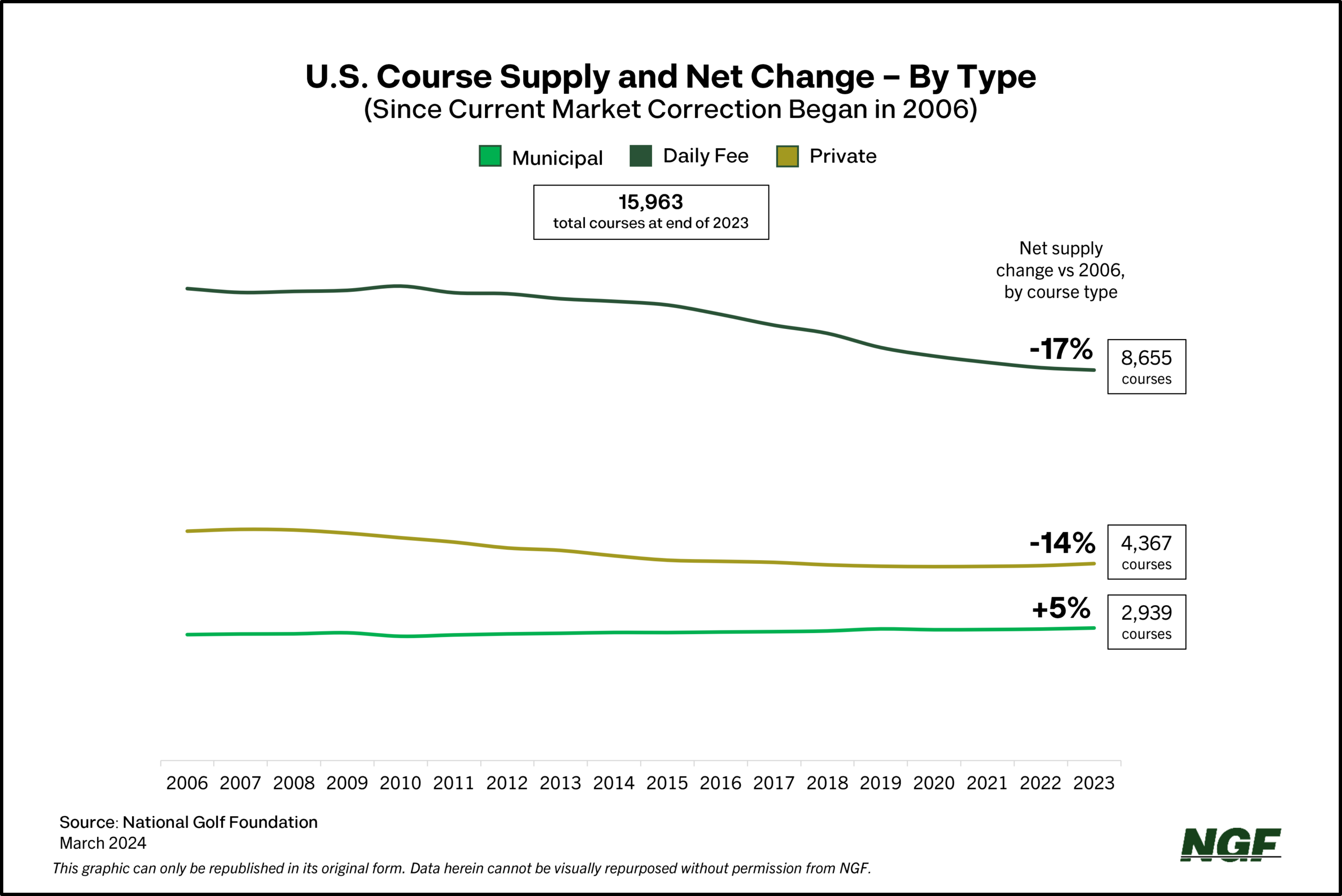( Click to listen to the audio version)
Many NGF Short Game readers might be surprised to learn that the number of municipal courses nationwide has actually increased over the past two decades.
There’s been a net gain of more than 140 muni courses since 2004, amidst a backdrop of a market correction that’s contributed to a 13% decline in U.S. golf supply over a 20-year span. The increase is in contrast with the broader reductions and the public/publicized challenges municipal golf encounters in some areas.
Municipal golf — defined as facilities owned or operated by government entities – is not facing an existential threat. In fact, the 2,939 municipal courses currently operating in the U.S. is an all-time high and represents just over 18% of the country’s overall golf course supply. One of them, Memorial Park in Houston, which was renovated prior to the pandemic in 2019 and sees over 65,000 rounds played annually, was the host site for this year’s PGA Tour Houston Open.
The increase in muni supply has been driven primarily through acquisitions and conversions, with municipalities taking over daily fee facilities or private clubs to provide affordable recreation for community residents.

This isn’t to say municipal golf doesn’t have challenges.
There are still high-profile fights for survival… and situations where the essence and economics of municipal golf aren’t well understood.
Making a profit isn’t necessarily the primary motivation that drives a municipality to offer golf as a recreational amenity. In many situations, a course is subsidized just like public parks, the county pool, local senior center, tennis complex or basketball facilities.
That said, municipal golf is generally in a better economic situation than pre-pandemic. Many of the recent markets we’ve been in and studied are looking to reinvest in upgrades at their golf facilities. Some of these courses that were being subsidized by a municipality’s general fund suddenly have fund balances they didn’t have four years ago. In a recent operator survey, almost three-quarters of municipal facilities indicate they’re in “good or excellent” health, a proportion that’s up from recent years.
Dire situations are fewer in number, although it’s important to note that many aging muni facilities face costly infrastructure improvements or upgrades. In markets with several, or many, public golf options, courses like these on pricey property close to major population centers can draw intense interest for potential development.
While a lack of profitability at some municipal courses isn’t surprising, the reality is that close to 75% of all public-agency golf facilities collect enough revenue to cover on-site labor and maintenance expenses.
From an interpretation standpoint, one of the bigger hindrances for muni golf is that there are no standardized accounting principles. This can make it difficult to define profitability within the world of municipal golf. Some municipalities tack on deeper off-course obligations such as administrative overhead, retirement system commitments, depreciation, and other general fund service charges, as well as “below the line” items such as debt service and capital expenditures, meaning many facilities can fall short of covering all these associated expenses. Others won’t.
Municipal golf has a long and storied place in the game’s history.
These facilities are often where golfers play for the first time and where golf is most affordable and accessible. If you take a close look at who is playing at your local muni course, chances are you’ll find a customer base that looks like a diverse cross-section of local residents of all ages, genders, and ethnic backgrounds.
- In many cases, these munis provide an oasis of open space in areas often choked by over-development.
- On average, the cost of an 18-hole round at muni courses is about 8% less than at non-resort daily fee courses.
- 71% of Core golfers (8+ rounds annually) indicate they had some of their earliest golf experiences at a municipal course.
Municipal golf is vital for the game’s future growth, and any reported demise is greatly exaggerated. Right now, the muni golf universe is larger and perhaps healthier than ever.



